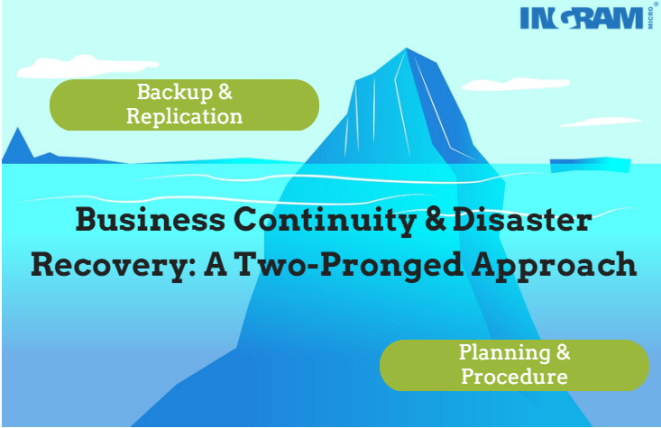You’re the CIO of a major airline, and you just got the dreaded call – there’s been an equipment failure and your main tracking and ticketing programs are inaccessible. As a result, thousands of flights have been cancelled and the PR nightmare has just begun.
Unfortunately, this story has played out in the headlines multiple times, shining a light on the importance of Business Continuity and Disaster Recovery (BC/DR) in a palpable way. The key to effective BC/DR is two-fold: Backup and Replication alongside detailed Plans and Procedures.
The primary and most fundamental step in BC/DR is the backup and replication of data so that in the instance of a failure, the backup data copied from various Virtual Machines (VM’s) can be easily spun up within the same data center or other replicated environments. Veeam, one of Ingram Micro’s most successful backup and availability vendors, urges customers to live by the “3-2-1 Rule:” Have at least 3 copies of your data, store the copies on 2 different media, and keep one backup copy offsite. According to William Pawlak, Ingram Micro’s Vendor Business Manager, Veeam’s greatest value to resellers is its Recovery Time Objective (RTO). “Ultimately, the main question is ‘How long can you be down?’” says Pawlak. Veeam has regularly evidenced a 5 minute RTO, which allows businesses to have availability to that data before it causes many major issues with customers.
And now you’re safe, right?
According to the experts, you’re only halfway through the full BC/DR process. The second piece of the process is a detailed and documented procedure plan. In the instance of a serious disaster such as a terrorist attack or major earthquake, you may not have access to all of your traditional IT experts on staff. According to 20-year industry expert Nick Vermiglio, a member of the Ingram Micro Consulting & Enablement team, having a detailed procedure plan in place will be the key to success during an incident. “In a major event, your UNIX administrator might not be around. This plan will ensure that even the janitor can bring up the UNIX server,” Vermiglio says. The plan should be written with plenty of detail and include all pertinent information including location of the server, exact commands, and specific keystrokes so that non-technical staff can replicate the availability of your IT team. Vermiglio continues to explain: “Without a procedure plan, having your backup and replication in place is like having ‘islands of data’” that are useless without the staff to make the necessary connections.
Once this plan is written and reviewed, it must be thoroughly tested. Bernie Franczak, a 30-year industry expert also on Ingram Micro’s Consulting & Enablement team, notes that “[a business] needs to be able to test a site and fix any holes before they become issues in a disaster situation.” Having non-technical staff test the environment and work through the steps in the plan ensures that the language is clear enough is a best practice to ensure the best outcome in a disaster situation.
While we may never know what has caused the technical outages in some of the recent news stories, businesses can use these cautionary tales to proactively ensure that their own Business Continuity/Disaster Recovery strategies are in order. Ingram Micro’s Digital Transformation Solutions team can help you to develop and fine tune your BC/DR strategy using resources with the expertise to customize a plan that meets your needs.
Contact the Ingram Micro Digital Transformation Solutions team at dxsolutions@ingrammicro.com to get connected with a consulting resource today.

